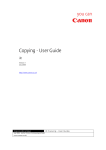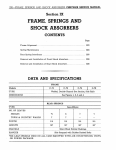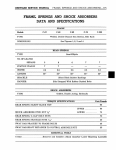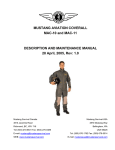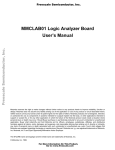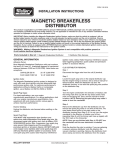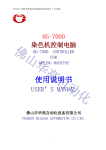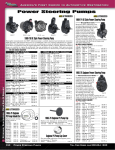Download SPRINGS AND SHOCK ABSORBERS
Transcript
GROUP 17 SPRINGS AND SHOCK ABSORBERS CONIINTS Page Page 1 1 3 SHOCK ABSORBERS . . . . ............ 2 SPECIFICATIONS (At Rear of Manual) TIGHTENING REFERENCE . . . . (At Rear of Manual) DESCRIPTION . . . . . . . . . . . . . . . . . . . . . SERVICE DIAGNOSIS REAR SPRINGS Description It is important that spring " U " bolts be inspected at regular intervals and kept tight to prevent spring breakage. The spring shackles should be inspected occasionally to make sure they are tight, but not binding. N o lubrication of any kind should be used on the rear springs or rubber bushings. Zinc Interleaves—Zinc Interleaves are used between the spring leaves for heavy duty suspension equipped vehicles to help increase spring life. Zinc Interleaves are flat pieces of zinc or metal to help cush- ion the spring leaves. They are used between each leaf for heavy duty suspension. Springs may "bottom" under abnormal loading conditions, particularly when road dips and railroad crossings are encountered at relatively high speeds. The oriflow shock absorber cannot be refilled or disassembled. When servicing is required, the shock absorber must be removed and a new unit installed. NOTE . Shock absorbers should only be replaced if they have lost their resistance, are damaged, or if they drip oil. Evidence of slight oil moisture on outside of shock absorber is not cause to replace them. 8 SERVICE DIAGNOSIS Condition Possible Correction Cause S P R I N G S A N D SHOCK ABSORBERS SPRINGS S A G OR (a) Springs sagged or taken set. (a) Replace spring. BOTTOM (b) Broken, bent or weak spring leaves. (b) Replace spring main leaf, or spring as necessary. SPRING NOISE (a) Loose " U " bolts. (a) Tighten " U " bolt nuts 45 foot-pounds. (b) Replace bushings and tighten shackle bolt nuts (b) Loose or worn shackle bushings. 40 foot-pounds. (c) Install new interliners. (c) Worn or missing interliners. (a) Tighten " U " bolt nuts 45 foot-pounds. SPRING BREAKAGE STRUT C R A C K I N G (a) Loose " U " bolts. (b) Replace spring and shock absorber. (b) Shock absorber inoperative. (a) Tighten the strut bushing bolt nut to 65 foot- (a) Loose strut bushing bolt nut. (b) Install new bushing. Tighten bushing bolt nut to pounds. OR GRUNTING N O I S E AT REAR O F IMPERIAL MODELS 65 foot-pounds. (b) Faulty strut bushing. (a) Replace bushings. S H O C K ABSORBER (a) Bushing excessively worn. NOISY (b) Faulty internal valve. (b) Replace shock absorber. (c) Air trapped in unit. (c) Bleed the shock absorber. (a) Faulty seal. (a) Replace shock absorber. S H O C K ABSORBER DRIPPING OIL 17-2 SPRINGS AND SHOCK ABSORBERS SERVICE PROCEDURES SHOCK ABSORBERS Front Shod Absorber Removal (1) Remove the nut and washer (Fig. 1) from the up- per end of the shock absorber control rod. (2) Compress the shock absorber by pushing the rod through the shock absorber support. (3) Remove the lower mounting bolt and remove the shock absorber. (4) If the upper bushing appears worn, damaged or deteriorated remove it by first pressing out the inner steel sleeve, then prying-out or cutting-out the rubber bushing. (This bushing takes some permanent set so that once removed it should be replaced.) (5) If the lower bushing is to be replaced, remove it from the shock absorber, using Tool C-3553 to press on the outer sleeve of the bushing (Fig. 2). (Pressing on the inner sleeve will not remove the outer sleeve from the shock absorber.) Installation (1) To aid the installation of the upper bushing, dip the bushing in water, start it into the frame opening with a twisting motion, then press or tap it into place. When installed properly, the groove in the bushing will index with the opening in the shock absorber tower. (2) Install the steel sleeve in the bushing. KP71 Fig. 2 — R e p l a c i n g Shock Absorber (3) Using Tool C-3553, press the lower bushing into the shock absorber eye until it is centered. Always press against the outer steel sleeve to avoid damage to the assembly. (4) Bleed and test the shock absorber then compress it to the shortest length. (5) Install the lower cup washer (concave side up) on the rod and into position. (6) Hold the shock absorber in the installed position in the frame. Slide the upper cup washer (concave side down) over piston rod and down onto the bushing. Install the nut finger tight. (7) Position the lower end of the shock absorber in the mounting bracket on the lower control arm, and NK542 Fig. 1—Front Shock Absorber Bushing Fig. 3—Rear Shock Absorber SPRINGS A N D SHOCK ABSORBERS 17-3 install the retaining bolt, lockwasher, and nut. Tighten the nut to 55 foot-pounds. While holding the piston rod, tighten the piston rod nut to 25 foot-pounds. Rear Shock Absorber Replacement On Imperial models, the rear shock absorbers are mounted on studs at the upper and lower ends. On Chrysler models, the shock absorbers are attached to studs on the lower ends and by bolts at the upper ends (Fig. 3). (1) Remove nuts and washers attaching the shock absorbers. (2) Inspect the bushings for wear or damage and replace as necessary. (3) Test and bleed the shock absorber. (4) Position the shock absorber on the mounting studs or bolts and install the cupped washers and nuts. SPRING SP-3178 N Y 204 F i g . 4—Spring Pivot Bushing Replacement Do not tighten the nuts until the full weight of the vehicle is on the wheels. (5) Tighten the lower stud nut 50 foot-pounds and the upper nuts 70 foot-pounds. Testing and Bleeding Shock Absorbers Hold the shock absorber in an upright position with the dust shield or piston rod section upward. Extend the shock absorber to the maximum length and turn it upside down. Compress the shock absorber. Repeat this procedure to make sure all air is removed from sorbers are fully extended. (2) Remove the alignment clips from the spring. (3) Separate the spring leaves (Fig. 5) and remove the interliners. Installation (1) With the leaves separated, be sure the spring leaf area where the interliner makes contact, is clean and smooth. the unit. Do not extend shock absorber when it is in the upside down or in a horizontal position, otherwise air will enter the cylinder tube. A steady resistance should be felt when the shock absorber is extended or compressed. If no resistance is felt, replace the shock absorber. REAR SPRINGS Front Pivot Bushing Replacement Removal of the old bushing and installation of the new bushing is performed in one operation using Tool C-3709 (Fig. 4). (1) On bolt SP-3178, position the bearing washer SP-92, thrust bearing SP-332, bushing adapter SP-3179 (flat side of adapter next to the washer), spring leaf bushing and remover adapter SP-3180. (2) Insert bolt SP-3178 through the bushing to be removed. (3) Install adapter SP-3242 on bolt SP-3178. The slot in adapter SP-3242 should be visible to aid in the correct positioning of the bushing as it is being installed. (4) Tighten bolt SP-3178 to remove the old bushing and install the new bushing. Remove the tool after the new bushing has been correctly positioned. 61x269B F i g . 5 — S e p a r a t i n g Spring Leaves REAR SPRING INTERLINERS ;; Removal (1) Raise the rear of the vehicle until the shock ab- F i g . 6 — P o s i t i o n i n g the Interliner 61 x 2 7 0 B 17-4 SPRINGS AND SHOCK ABSORBERS (2) Insert the interliner between the spring leaves (Fig. 6) until the fasteners are aligned with the holes. (3) Force the fastener into the hole in the spring leaf (Fig. 7). (4) Position the aligning clip (Fig. 8) and tighten the retainer nut. Do not lubricate the rear springs. The interliners act as the friction control and need no lubrication. ZINC INTERLEAF REPLACEMENT (Heavy Duty Suspension—AC-1, A C - 2 , A C - 3 Models) (1) Remove the rear spring. (2) Remove the center bolt from the spring and separate the leaves. (3) Install the zinc interleaves between the spring leaves and install the center bolt. (4) Tighten the center bolt to 10 foot-pounds. Measuring Rear Spring Height When measuring the rear spring heights, the vehicle should be placed on a level floor, have the correct front suspension height, the correct tire pressures, no passenger or luggage compartment load and a full tank of fuel. (1) Jounce the vehicle several times (front bumper first). Release the bumpers at the same point in each cycle. (2) Measure the shortest distance from the highest point on the underside of the rear axle bumper strap (at the rear of the bumper) to the top of the axle housing. (3) Measure both the right and left sides. If these measurements vary by more than % inch (from side to side), it is an indication that one of the rear springs may need replacing. It is normal for rear springs to show some reverse arch, even with no load, so appearance alone should not be the reason for spring replacement. Rear Spring 61 x 2 7 2 B F i g . 8—Positioning Clip floor stands and jack pressure under the axle housing, disconnect the shock absorbers from the studs on the spring plates. (2) Lower the jack until it supports only the weight of the axle housing and remove the rear spring rear shackle (Fig. 9). (3) Loosen the rear spring pivot bolt nut. The nut should be backed off until it is retained on the pivot bolt by two or three threads. (4) Using a pry bar between the pivot bolt nut and the body frame, force the pivot bolt outward until the nut contacts the spring mounting bracket. (5) Remove the pivot bolt nut and using a suitable tool, force the. pivot bolt out of the spring. (6) Remove the spring " U " bolts and the spring. Rear Spring Installation (1) Position the springs in their respective front NUT INSERT C.._ / BUSHING PLATE STATION WAGON Removal Alignment SPRING SHACKLE (1) With the vehicle body frame supported on the SHACKLE BUSHING BUSHING SCREW NK536 61 x 271B Fig. 7—Installing Interliner Fastener Fig. 9 — R e a r Spring Assembly SPRINGS AND SHOCK ABSORBERS hangers and install the pivot bolts and nuts (finger tight only). (2) Install the spring shackles and nuts. (3) Install the spring " U " bolts and nuts. (4) Tighten the spring U-bolt nuts 50 foot-pounds and shackle bolt nuts 40 foot-pounds. (5) Connect the shock absorbers. 17-5 (6) Remove the vehicle floor stands and with the vehicle weight on the wheels, tighten the front pivot bolt to 125 foot-pounds torque. (7) The bushings and shackles should not be lubricated at any time. Measure the vehicle curb height whenever a rear spring or shackle has been replaced.





